"Into the Unknown World - Gutai: Differentiation and Integration" Photo Report
Exhibition at the National Museum of Art, Osaka; (Center) Tsuruko Yamazaki "Red" 1956/85, Hyogo Prefectural Museum of Art (The Yamamura Collection); (Left) Sadamasa Motonaga "Nobi Nobi" 1971, The National Museum of Art, Osaka
Long-awaited retrospective exhibition in Nakanoshima
Almost 40 years after the project’s announcement, the Nakanoshima Museum of Art, Osaka, opened in February 2022. Along with the neighborhood National Museum of Art, Osaka, whose collection includes contemporary artworks from Japan and abroad, both museums present the exhibition “Into the Unknown World - Gutai: Differentiation and Integration” from October 22 through January 9, 2023.
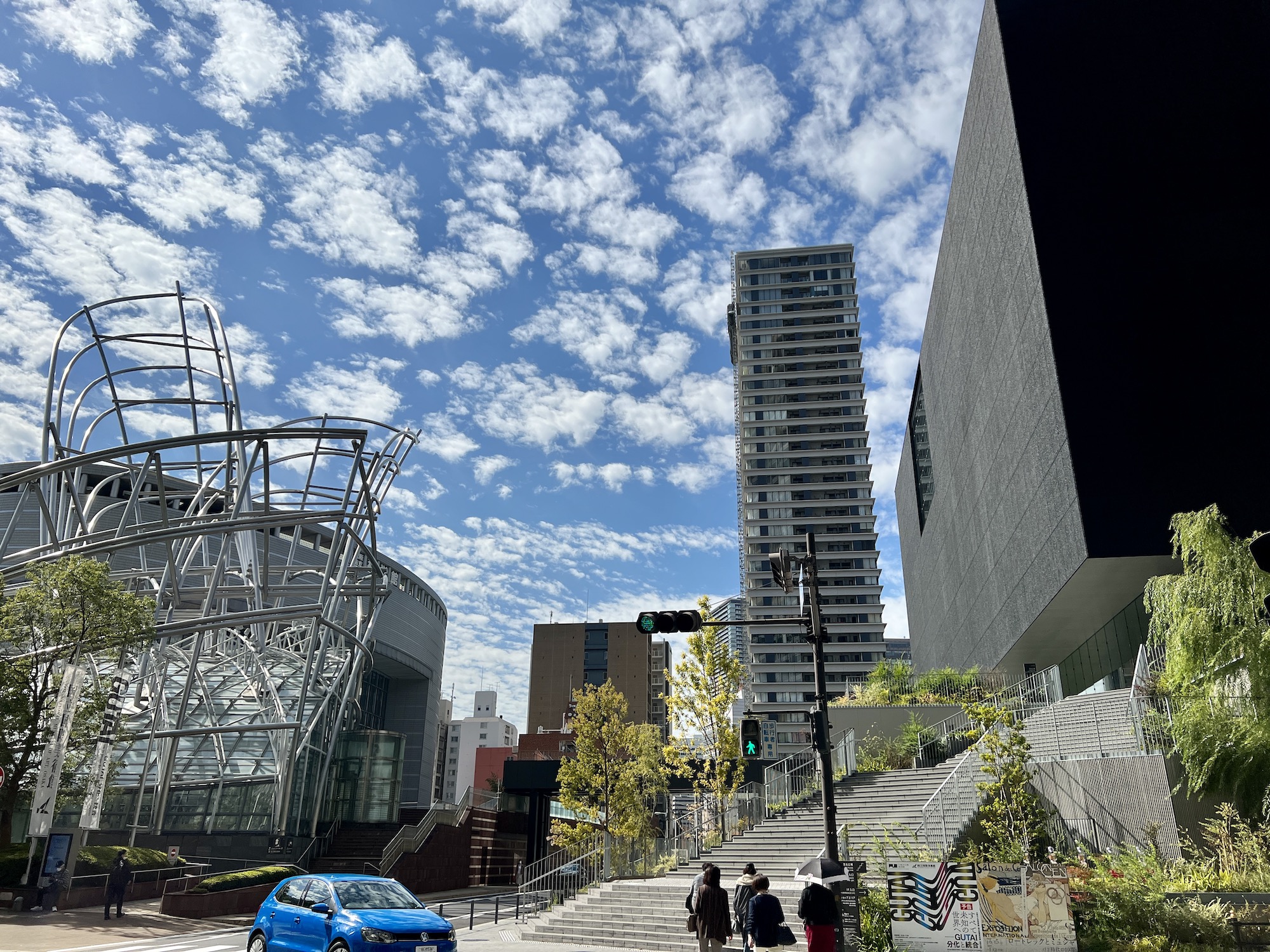
It is a large-scale retrospective exhibition held on the occasion of the 50th anniversary of the dissolution of the Gutai Art Association (Gutai). Gutai was an avant-garde artist group formed in Ashiya (Hyogo Prefecture) in 1954, which was led by painter and businessman Jiro Yoshihara (1905-72). Many of its members, such as Atsuko Tanaka, Kazuo Shiraga, Sadamasa Motonaga, Tsuruko Yamazaki, and Saburo Murakami, held large-scale solo exhibitions after the dissolution of Gutai in 1972.
In recent years, Gutai has been gaining international acclaim as an essential part of postwar art history to the extent that it has almost become a legend. Based on the book “Gutai: Decentering Modernism” by Ming Tiampo, the Guggenheim Museum in New York held the “GUTAI” exhibition in 2013 and works by Kazuo Shiraga and others have increasingly gained popularity and raised in price, drawing even more attention to them. However, the reputation of Gutai has never been stable and has undergone dynamic changes over the years. It is well known that at the time of their activities, the Tokyo-centered art world and art criticism rather neglected Gutai Art Association, and reputation has been further complicated by close association with the French critic Michel Tapié, who coined the term “Art Informel.” A major turning point came in the 1980s with the publication of Shigeo Chiba’s “Contemporary Art: History of Deviation,” which positioned Gutai as the origin of the postwar Japanese art movement. However, Gutai’s recognition was focused solely on their early period, and after being influenced by Art Informel, their work was regarded as unoriginal.

Since then, as a group and as individual artists, Gutai has been studied by researchers and curators in Japan and abroad, and their international reputation is stronger than ever. One cannot help but have high expectations for a major retrospective exhibition in Kansai, the group’s former base. Nakanoshima is also closely associated with Gutai Pinakoteka, the private museum and exhibition space of Gutai established by Yoshihara between 1962 and 1970. With such expectations in mind, what new image of the Gutai Art Association can be presented to contemporary viewers?
The title presents two keywords, “differentiation” and “integration,” which are taken from Jiro Yoshihara’s “Gutai Art Manifesto,” written in 1956. Although this is a simultaneous exhibition, each museum took its own approach. While the Nakanoshima Museum of Art presented representative and relatively unknown works, the National Museum of Art focused on Gutai’s starting point as a group of painters and developed a more critical approach.

Differentiation: Nakanoshima Museum of Art, Osaka
Through their paintings and artistic activities, Gutai Art Association sought to present proof that their spirit is free. The words “wonderful effects of differentiation and integration,” as Yoshihara also described it, can be compared to the state where “human spirit and matter shaking hands but remaining apart.”
Chief curator Kunii described the characteristics of the exhibition as follows:
① “Differentiation” perspective focuses on the individual artists and highlights the “originality” of Gutai.
② Exhibition has four keywords: space, material, concept, and place.

The first section, “Chapter 1: Space,” explores approaches to specific spaces. For example, Atsuko Tanaka’s representative piece “Electric Dress” emits a bright light across the room, while “Work (Bell)” rings in sequence when the switch is pressed.
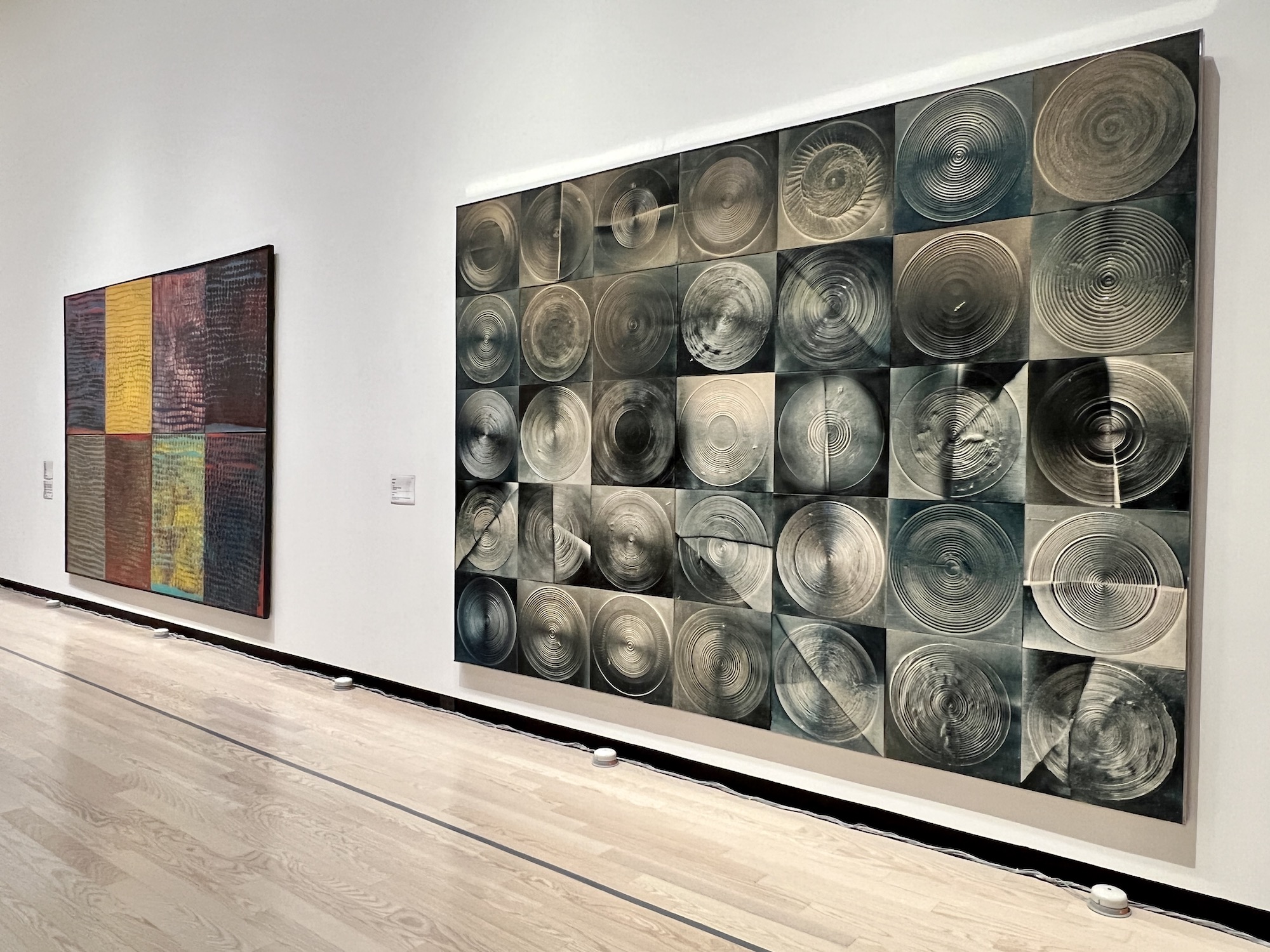

Many of Gutai’s works are characterized by their size, and many are already lost. Nasaka Yuko, who also participates in the exhibition, had her “obsession with large works” pointed out by Jiro Yoshihara. A “Work” made of paper tape by Michio Yoshihara, a son of Jiro, also greets viewers as they enter the exhibition room, overwhelming them with color and size.
In the catalog (p. 33), Kunii compares Gutai’s works to “environmental art” that emerged in the 1960s, arguing that their works “can be described as an erosion of space, as they occupy space while maintaining clear boundaries between the inside and outside of the work.”



Chapter 2 focuses on “materials,” which were extremely important to Gutai. In this chapter, viewers can observe Gutai’s experimental spirit of using new materials, such as industrial products that became popular after World War II, and their intention to incorporate everyday objects into their works. First and foremost, Jiro Yoshihara used to say, “don’t imitate others; make something that has never been done before,” which inspired the artists in the group.

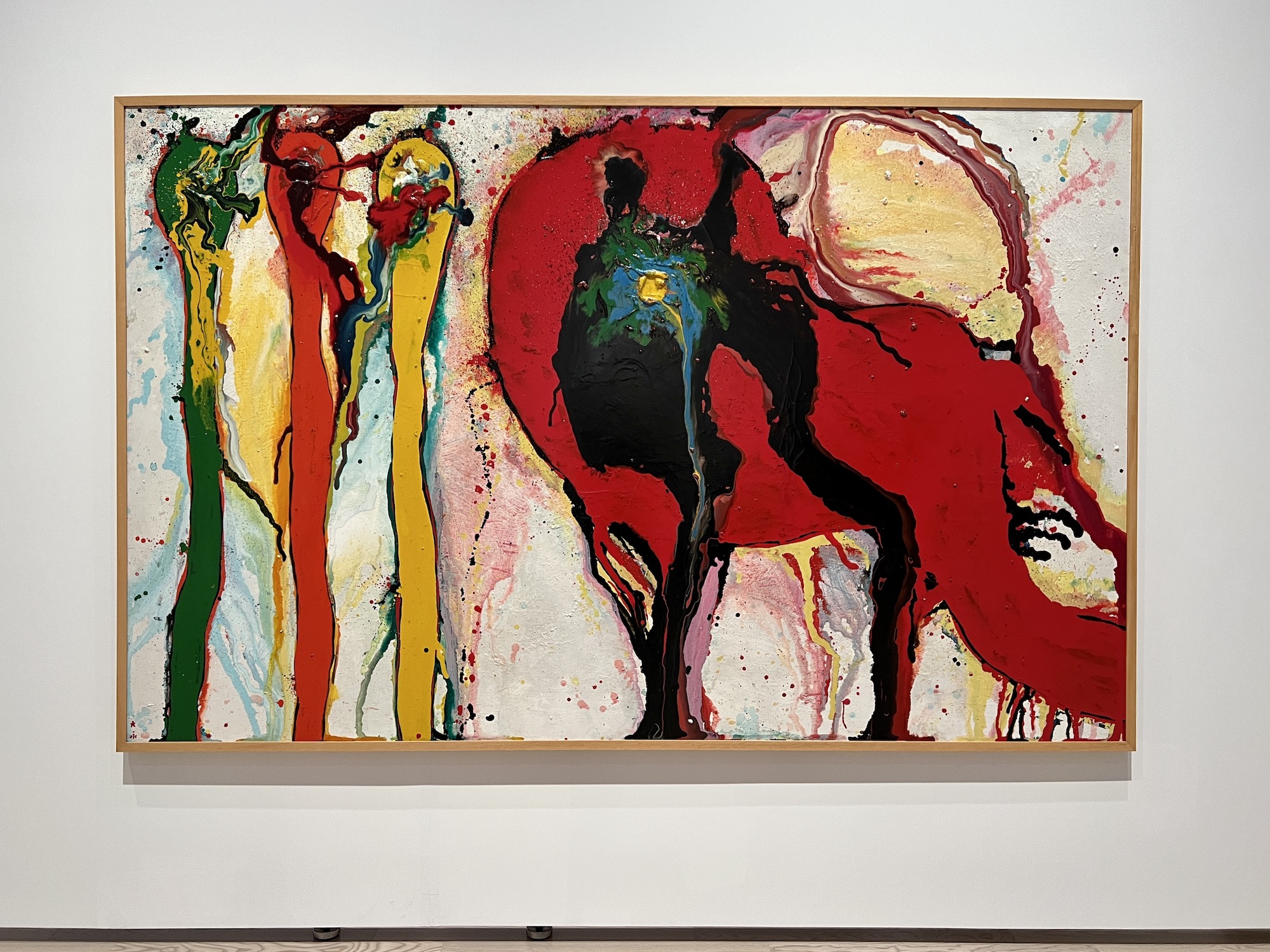
Chapter 3 focuses on Gutai’s conceptual works. One example is Akira Kanayama, who created paintings by attaching paintbrushes and pens to a radio-controlled car. Although reminiscent of Jackson Pollock’s “action paintings,” Kanayama says that he can’t do actions because his mind is more “compositional.” Therefore, using radio-controlled cars, Kanayama created paintings with lines free from physicality and emotions.

Saburo Murakami’s glass cube “Air” test the audience with its humor. This may be surprising, but it’s a cellophane tape that holds the glass panels together. The tape used so often in households and offices nowadays was a relatively new material, introduced by GHQ after the war and later manufactured and sold in Japan. Such details highlight Gutai’s interest in specific materials and substances.

Another example is Murakami’s “peeling painting,” in which paint peels off as the glue layer dries and shrinks. Murakami, who was greatly interested in “time,” created this work by embracing the changes that occur over time.

Kazuo Shiraga’s signature “foot paintings” tend to draw attention to their action element, but this exhibition emphasizes that the method is a strong concept. Started by Shiraga around 1954, foot painting is a method in which he hangs from a rope suspended from the ceiling and slides his feet across a canvas spread out on the floor. The wood sculptures are also a product of Shiraga’s consistent philosophical attitude toward creation.

For Tsuruko Yamazaki, “color” was a major field of exploration. Her experimentation was not limited to tableaus but also extended to pieces made of tinplate and other materials. Her works are one of the most colorful and pleasing in this exhibition.


Shuji Mukai, whose works frequently feature symbols, presented his new installation, “Restroom with Nonsense Symbols,” which covers the entire bathroom on the fifth floor of the main building.
Chapter 4, “Place,” introduces Gutai’s outdoor and on-stage activities, including the “International Sky Festival” held in 1960 on the rooftop of the Takashimaya Department Store, where paintings were hung on balloons and exhibited in the air. Overseas artists participated in the exhibition by sending sketches to Japan, which were then enlarged and painted by Gutai artists, resulting in an international collaboration.


In addition, the exhibition features interviews with Norio Imai, Shuji Mukai, and Takesada Matsutani, who joined the group in the latter years of its activities. Artist shared memories of Jiro Yoshihara, who sought “something that had never been done before” but never provided a detailed explanation for his judgment of works.
Integration: National Museum of Art, Osaka
The works of Sadamasa Motonaga and Kazuo Shiraga greet viewers at the beginning of the exhibition at the National Museum of Art, Osaka.

The exhibition at the National Museum of Art, Osaka, explores the originality of Gutai’s activities with a focus on “paintings.” Chapter 1, “The Handshake,” opens with the question of what Jiro Yoshihara meant when he spoke of a state in which “human spirit and matter shaking hands but remaining apart.” The chief researcher Takashi Fukumoto explains, “there is the ‘subject,’ the painter, and the ‘objects’ of the painter’s action, such as materials. Yoshihara and Gutai artists attempted to overcome this relationship of control.”
According to Fukumoto, one way to do so is to “elevate the position of the material.” Gutai painters incorporated materials they had no control over, such as large amounts of matches or pebbles, into their works. Another way is to “lower the spirit of the painter.” This can be seen in the works of Kaneyama or Shiraga, where they purposefully didn’t paint with their hands but used other methods that forced them to be clumsy.


There is also the “repetition” technique, similar to when the person claps their hands and is somehow carried away by the rhythm.


Chapter 2, “Empty Content,” explores the “meaningless” found in various practices of Gutai. The “empty” from the chapter’s title comes from the words written by Tsuruko Yamazaki. Gutai’s exhibitions were often criticized for the lack of content, but Yamazaki turned that criticism around by saying, “words like ‘nothing’ and ‘empty’ sound quite pleasing,” and added on the potential of emptiness, “it is the place where various new questions and possibilities, separated from the existing ones, are proposed, and where the world is buzzing with suggestions and revelations.”
Among the works presented here is Yamazaki’s famous mosquito net piece “Red,” which was once exhibited at the open-air Gutai Art Exhibition (1956). It is “empty” inside, but its bright red reflects throughout the exhibition space and interferes with the other works, giving it a strong sense of presence.


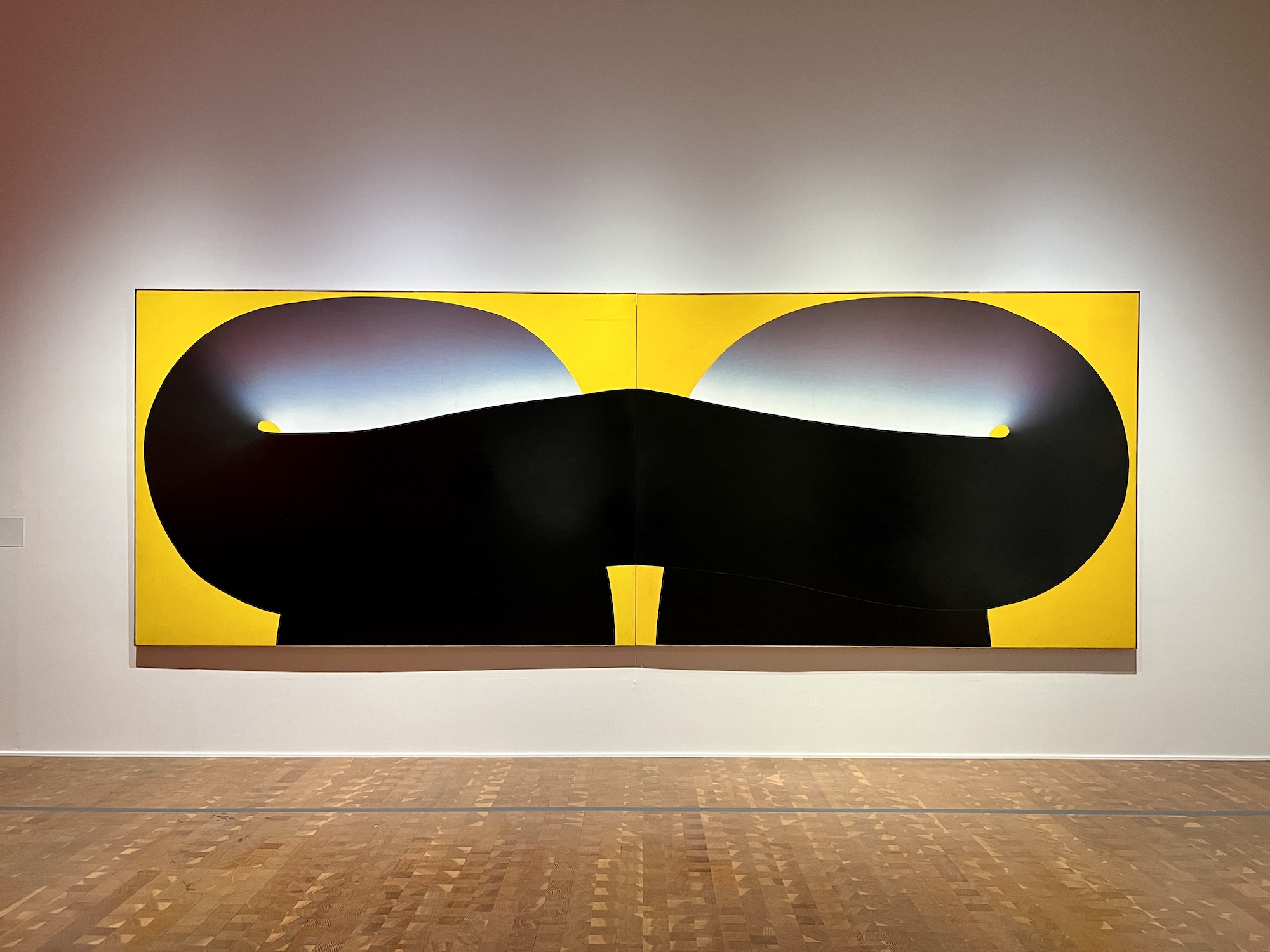

Chapter 3, “Not Limited to Painting,” introduces the experimental attempts of members who started as painters. What is important, however, is that such action-like and installation-like expressions were not unrelated to painting but were considered an extension of painting. Saburo Murakami’s “peeling paintings” are a good example of that.

The chapter also features paintings that seem to extend beyond the frame. Jiro Yoshihara’s “Work C” depicts red spots reminiscent of the kanji character on the blue background. But it is up to the viewer to imagine a shape beyond the painting frame.
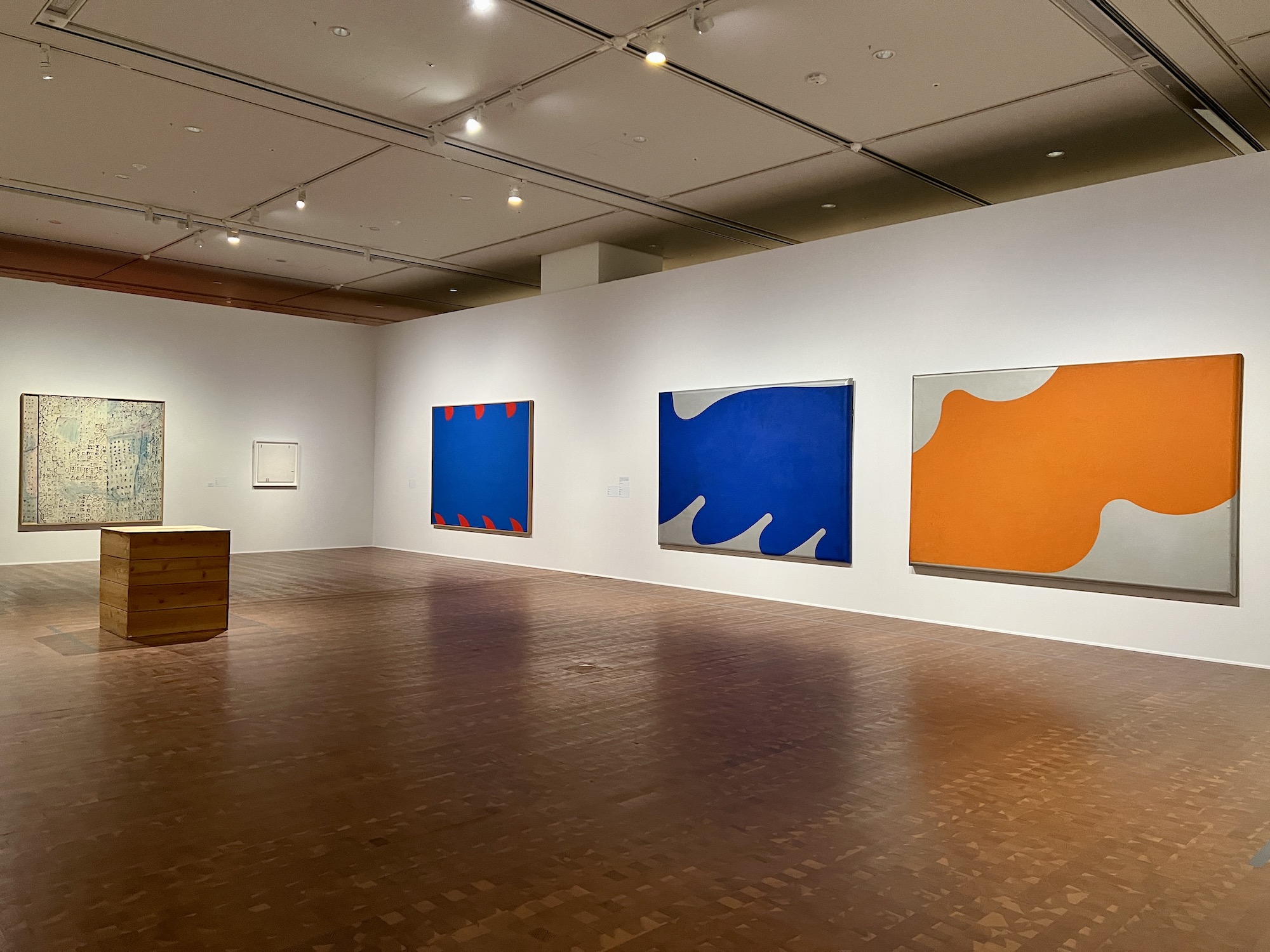
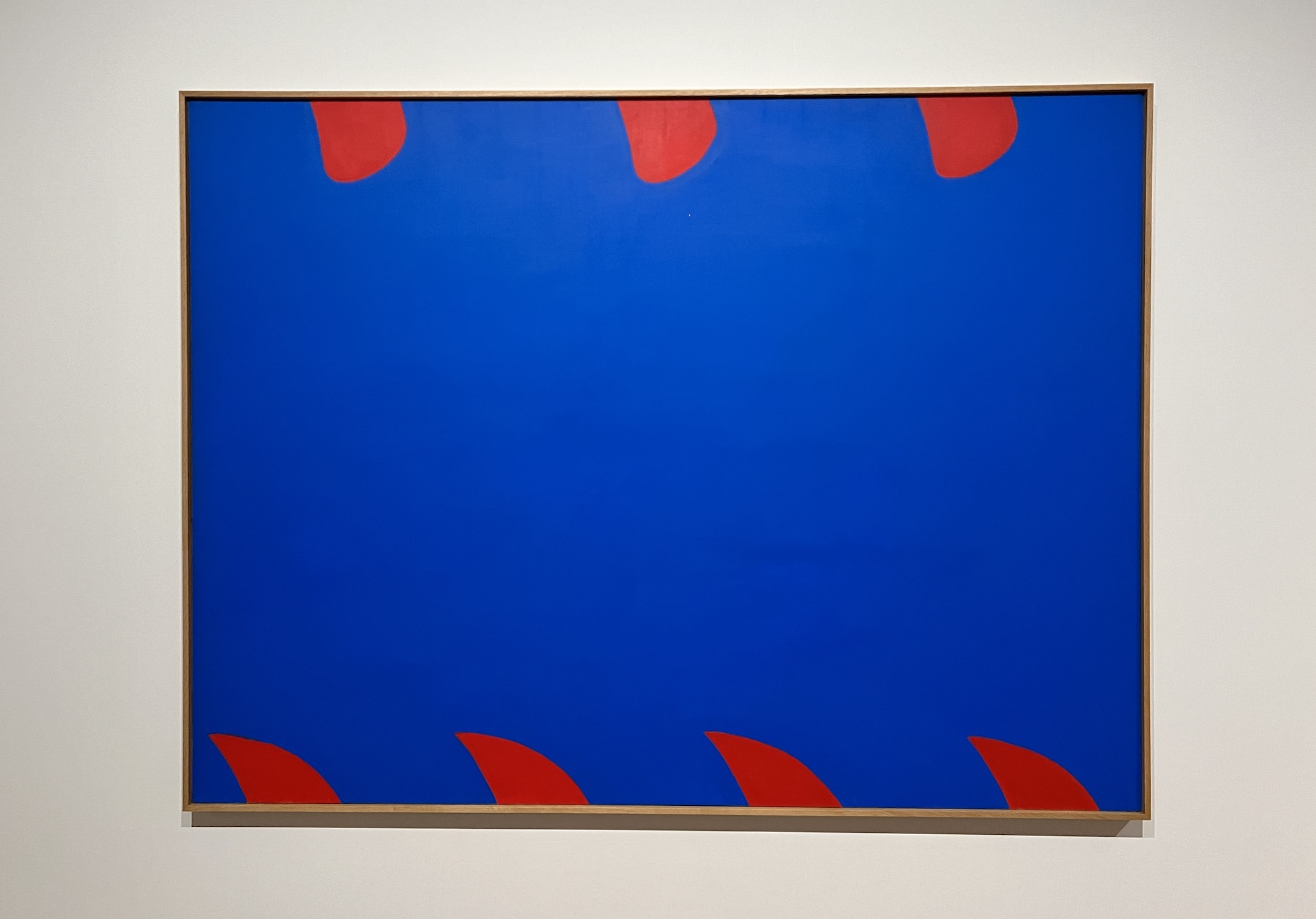


Although the intense “red” seen in the works of Tanaka, Shiraga, Yamazaki, and others have dominated the image of Gutai, the younger artists who joined the group later were not bound by its presence. For Norio Imai, white is “a passive color, but at the same time, it is a color that embraces many things.” For the exhibition under the theme is “integration,” it is very symbolic to end on such a note.
As you can imagine, both museums have a lot to offer, and if time allows, we encourage you to see both exhibitions. On the other hand, the exhibition did not seem to capture the “enthusiasm” of the group as a dynamic organization in which artists came up with surprising ideas and engaged in friendly competition with each other, the excitement of the action-like and installation-like works, or the publication of the journal “Gutai” and strategies for international collaboration, both of which Yoshihara considered important. This is partly due to the almost complete absence of archival material on display. Although the exhibition focuses on paintings, references to the influences of Art Infomel and Tapié are limited to the extent that one gets the impression that they were intentionally avoided. It would have also been beneficial to have more explanation or introduction of the Gutai Pinakoteka, which once existed in Nakanoshima and was the inspiration for this exhibition.
However, asking to show everything in a very limited space would be unreasonable. This exhibition indeed created a new “Gutai exhibition” by presenting different themes in different locations. The Nakanoshima Museum of Art, Osaka, is reported to have 800 works in its collection by Jiro Yoshihara alone, as well as a vast archive of his activities. If this exhibition marks a new milestone in the history of Gutai, works and materials not included in this exhibition will likely be presented in a new format. Therefore, we can look forward to seeing new research surrounding the Gutai Art Association.



